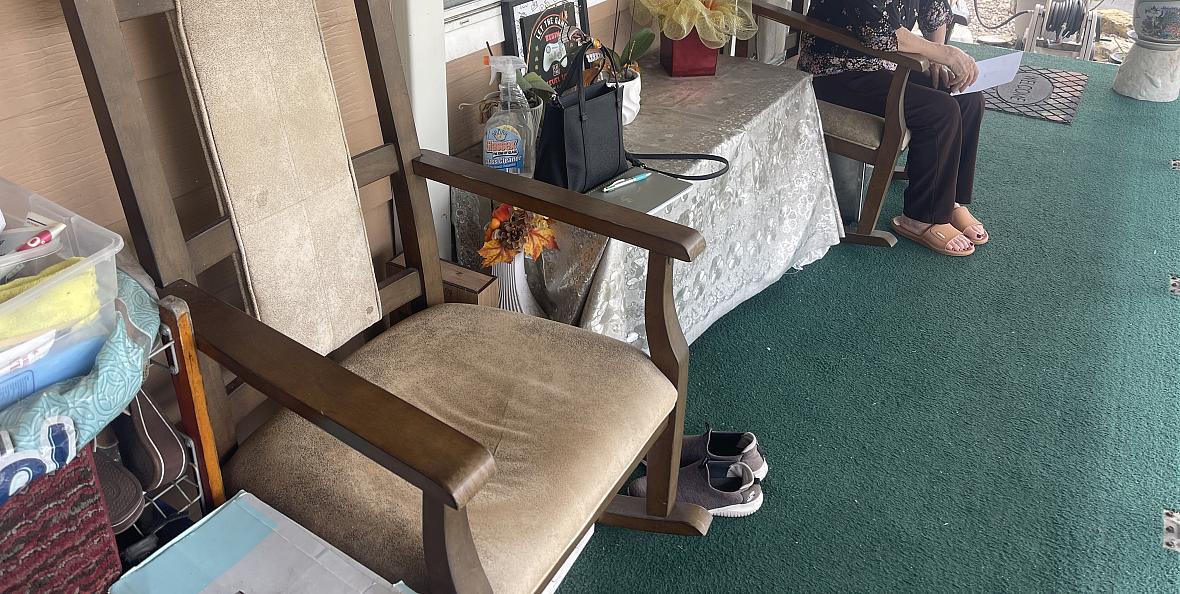Eviction Notices Cause "Emotional Terror" Say Senior Vietnamese Mobile Home Residents
The story was co-published with Nguoi Viet Daily News as part of the 2025 Ethnic Media Collaborative, Healing California.

The rocking chair on Ngoc’s deck before removal to comply with the park’s reminder. (Photo: Nhien Tra Nguyen)
When 87-year-old Ngoc Tran received a third notice from her mobile home park management in late August ordering her to remove flower pots and replace her rocking chairs in the deck or face “legal action,” she said she felt both anxious and powerless.
The notice stated that Ngoc had exceeded the five-pot limit, and that their rocking chairs did not match “acceptable” furniture which were placed soon after she bought the house.
“I got a headache every time the manager sent the warning,” Ngoc said. “I felt pressured and anxious, and didn’t know what to do.”
Ngoc and her 91-year-old husband have owned a unit at Kona Kai Mobile Home Park for seven years. Their home has long been a place of comfort and community. Yet in recent months, the couple has faced escalating warnings telling them to comply with the management’s demands.
California’s mobile home residency law (California Civil Code § 798.56) allows management to legally evict an owner for a rules violation under specific conditions, including failure to comply with a reasonable park rule included in the rental agreement.
Built in the 1950s,Kona Kai Mobile Home Park in Santa Ana, Orange County, is a quiet senior community with 208 units. A typical two-bedroom, two-bath home is listed for around $149,000, and the average space rent is about $875 per month. Today, roughly 145 Vietnamese families call the park home.
“We like to sit on the chairs to look at our flowers for our mental health,” Ngoc explained. “But the demands from management jeopardize it all.”
Each time a warning arrives, the couple must rely on their son – who lives far away – to translate and negotiate with park management.

Seniors often receive violation reminders telling them to comply with certain issues. (Photo: Courtesy of Kona Kai resident)
The prospect of eviction causes anxiety and prolonged stress to this aging couple who have few affordable housing options.
The broader picture: Housing costs outpace senior incomes
For seniors in Orange County, housing affordability has emerged as one of the most pressing challenges. A snapshot of the median rent of $3,560 per month in Orange County shows that it is double the national median. Many older adults on fixed incomes find themselves struggling to maintain housing stability. Roughly 40 percent of Orange County residents are renters, and those who rely on fixed incomes face especially precarious circumstances.
The average monthly Social Security benefit for a retired worker was $2,006.69 as of July 2025, according to the Social Security Administration (SSA) – far below what it takes to rent even a modest one-bedroom apartment locally.
According to the 2023 Elder Index, seniors in “good” health who rent in Orange County need an annual income of about $38,772 to cover basic living expenses – roughly 30% higher than the national average of $29,748.
Orange County is home to the largest Vietnamese community in the United States, with an estimated 180,000 to 215,000 residents – about 4.1% of the county’s population, according to the U.S. Census Bureau’s American Community Survey.
Within this community, many households are multi-generational, often sharing one roof to pool resources. Language barriers and limited English proficiency make navigating leases, code enforcement, or eviction notices difficult. Vietnamese seniors, in particular, carry a higher housing cost burden than the county average and often rely on mobile homes as one of the few semi-affordable options left.
There are 249 mobile home parks across Orange County, and some, like Kona Kai, are dedicated to senior living. These parks have become a safety net for many low-income seniors – providing relatively stable housing in a market with few affordable alternatives.
But even here, housing security is fragile.
Beyond rent: Housing insecurity and health
A 2022 California Housing Partnership report found that 1 in 3 low-income seniors in Orange County faces severe housing cost burdens. Researchers have linked eviction threats and compliance pressures to anxiety, depression, and hypertension among older adults.
Thanh Flynn, another Kona Kai senior resident, described a similar experience of harassment. “It was emotional terror,” she said. “I spent a few thousand dollars just to fix the painting in front of my house according to their demand. I got sick recently upon receiving the latest warning,” which also threatened “legal action.”
For Ngoc and other seniors, the stress is both financial and emotional. The fear of losing one’s home – or the small garden that gives daily joy – erodes their sense of safety and health.
Policy gaps and advocacy

Santa Ana is one of the first cities in Orange County to adopt a Rent Stabilization and Just Cause Eviction Ordinance, passed in October 2021. (Photo: City of Santa Ana)
Santa Ana is one of the first cities in Orange County to adopt a Rent Stabilization and Just Cause Eviction Ordinance, passed in October 2021. The law caps annual rent increases for mobile-home residents at 3% or 80% of the Consumer Price Index (CPI), whichever is lower, and requires landlords to justify any eviction.
But while the law regulates rent increases, it does not always prevent landlords from using code enforcement, management rules, or maintenance requirements as leverage to pressure tenants out.Local housing advocates argue that while Santa Ana’s rent control ordinance was a historic step, it has limited enforcement mechanisms to prevent harassment through rule-making.
Community groups like VietRISE and the Orange County Tenants United Coalition have previously documented cases of landlords in Santa Ana and Westminster using intimidation, property rules, and arbitrary notices to pressure immigrant and senior residents.
Paul Eakins, Public Affairs Information Officer from the City of Santa Ana, stated that the city’s Rent Stabilization Just Cause Eviction Ordinance is in place “to limit rent increases and prevent arbitrary evictions” to protect tenants from being displaced from their homes for unfair reasons.
Eakins also wrote that they participated in an educational workshop in partnership with VietRISE at the Kona Kai Mobile Home Park in July, where they “met with about 35 residents and provided them with important information on the provisions that the Rent Stabilization and Just Cause Ordinance can provide.”
Even in rent-controlled cities like Santa Ana, seniors and immigrant residents remain vulnerable to exploitation, shifting park rules, and the constant threat of eviction. As the city confronts a deepening housing crisis, the stories of Kona Kai’s residents reveal an urgent need for policies that safeguard not just the price of housing, but also the security, health, and dignity of those who live in it.
Without significant policy interventions and increased investment in affordable housing specifically designed for seniors, Orange County's aging population will continue to face displacement and housing insecurity in a region many have called home for decades.
“If you want to continue to live here, you have to comply with the demands hoping that would be enough,” Ngoc said, pointing to the empty space in the deck that was once the place of the two rocking chairs and the side table.
This project was supported by the USC Annenberg Center for Health Journalism, and is part of “Healing California”, a yearlong reporting Ethnic Media Collaborative venture with print, online and broadcast outlets across California.
